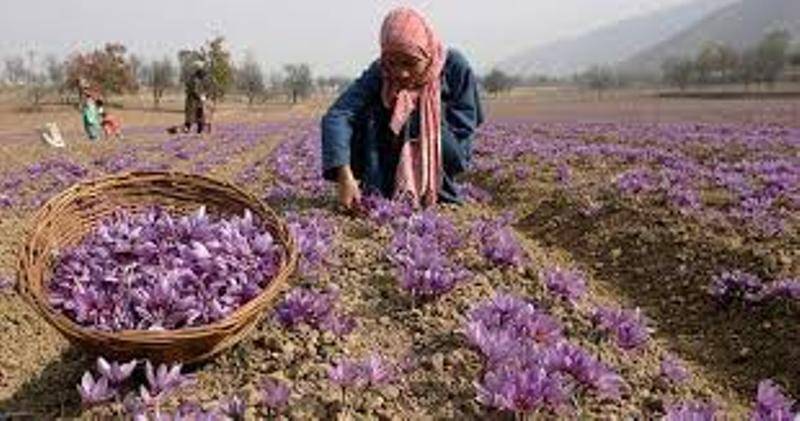GI tag for Kashmiri Saffron
Relevance: prelims/Mains: G.S paper I: Geography

Introduction
- Kashmiri saffron, produced in the Karewa (The Karewa Basin is located between the Pir Panjal Range and the Great Himalayan Range in the Kashmir Himalayas) of Jammu and Kashmir, has been given the Geographical Indication (GI) tag by the Geographical Indications Registry. The aromatic spice is grown in some regions of Kashmir, including Pulwama, Budgam, Kishtwar, and Srinagar.
- The application for GI tag was filed by the Directorate of Agriculture, Government of Jammu and Kashmir, and facilitated by the Sher-e-Kashmir University of Agriculture Sciences and Technology, Kashmir, and Saffron Research Station, Dussu (Pampore).
• Chinnaraja G. Naidu, Deputy Registrar of Geographical Indications, stated, “Kashmir saffron is a very precious and costly product. Iran is the largest producer of saffron and India is a close competitor. With the GI tag, Kashmir saffron would gain more prominence in the export market,” he added.
What is the GI tag and what is its importance?
- According to the World Intellectual Property Organization (WIPO), a GI tag (Geographical Indication) is a distinguishing sign related to products that originate from a particular place and which determines the special qualities possessed by the product. Let’s take, for example, tea is produced in different parts of the world. But what sets apart Darjeeling tea from the rest of the tea producers is its flavor, quality, and the specific area where it is grown which cannot be duplicated elsewhere.
Its importance:
- When a local product gets G.I tag, it gets special attention and preservation. Its value rises and it becomes much more valuable in the market.
• It provides legal protection to the product and encourages marketers to expand business globally.
• Helps in the economic prosperity of the producers and provides the right to take legal actions against fraudsters and save the reputation of G.I tagged product from being damaged.
• It also encourages people to visit the place of origin in order to get access to that product which eventually gives rise to tourism.
• G.I tag assures the consumer of a certain quality, reputation, and other exclusive characteristics of the product.
Who regulates G.I tags?
- G.I tags are covered under intellectual property rights (IPRs) under the Paris Convention for the Protection of Industrial Property. At the global level, G.I is regulated by the World Trade Organization’s (WTO’s) Agreement on Trade-Related Aspects of Intellectual Property Rights (TRIPS). However, in India G.I rules are regulated by the Geographical Indications of Goods (Registration and Protection) Act, 1999 which came into force with effect from September 2003.
Some Facts and Figures to Remember:
- Darjeeling Tea became the first G.I tagged product in India, in the year 2004-05.
• Karnataka has the highest number of G.I tags in India.
• There is a total number of 237 G.I products registered so far and over 270 more products have applied for the label.
What is so special about the Kashmiri Saffron?
- Saffron cultivation is believed to have been started in Kashmir by Central Asian immigrants around 1st Century BCE. Saffron is called “Bahukam” in ancient Sanskrit literature.
• Kashmiri saffron is the world popular as an aromatic spice. It revitalizes health and is used as the main ingredient in cosmetics and medicine production. It has been associated with traditional Kashmiri cuisine and represents the rich cultural heritage of the area. The unique characteristics of Kashmir saffron are its longer and thicker stigmas, natural deep-red color, high aroma, bitter flavor, chemical less processing, and high quantity of crocin (coloring strength), safranal (flavor) and picrocrocin (bitterness).
• It is the only saffron in the world which is grown at a very high altitude of 1,600 m to 1,800 m (above sea level), it adds to its uniqueness and differentiates it from other saffron varieties available in the world.
The saffron available in Kashmir are of three types:
- Lachha Saffron: with stigmas just separated from the flowers and dried without any processing.
• Mongra Saffron: in which stigmas are separated from the flower, dried in the sun, and processed traditionally.
• Guchhi Saffron: which is the same as Lachha, the only difference is that Gucchi’s dried stigmas are packed loosely and Lachh’s stigmas are joined together in a bundle tied with a cloth thread.
For more such notes, Articles, News & Views Join our Telegram Channel.
Click the link below to see the details about the UPSC –Civils courses offered by Triumph IAS. https://triumphias.com/pages-all-courses.php

